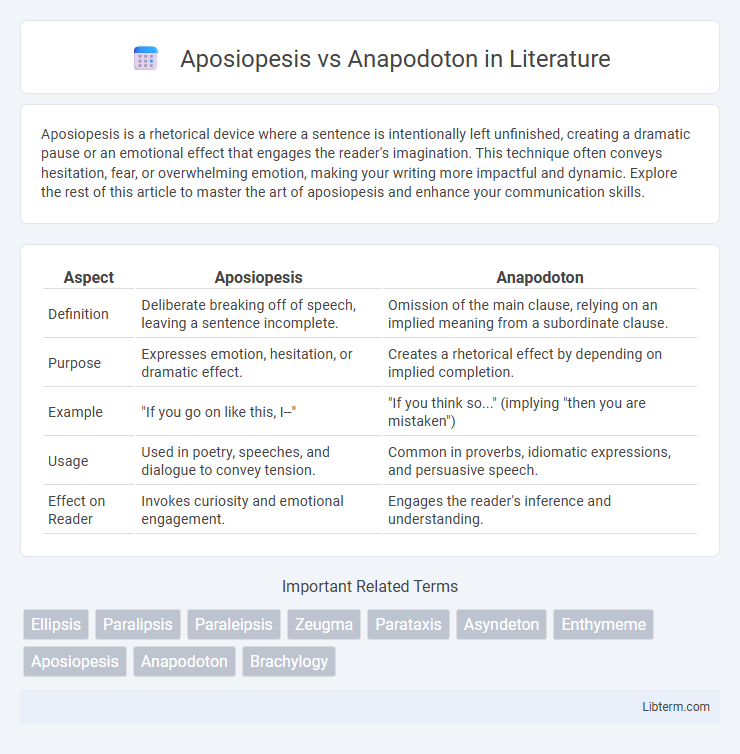Aposiopesis is a rhetorical device where a sentence is intentionally left unfinished, creating a dramatic pause or an emotional effect that engages the reader's imagination. This technique often conveys hesitation, fear, or overwhelming emotion, making your writing more impactful and dynamic. Explore the rest of this article to master the art of aposiopesis and enhance your communication skills.
Table of Comparison
| Aspect | Aposiopesis | Anapodoton |
|---|---|---|
| Definition | Deliberate breaking off of speech, leaving a sentence incomplete. | Omission of the main clause, relying on an implied meaning from a subordinate clause. |
| Purpose | Expresses emotion, hesitation, or dramatic effect. | Creates a rhetorical effect by depending on implied completion. |
| Example | "If you go on like this, I--" | "If you think so..." (implying "then you are mistaken") |
| Usage | Used in poetry, speeches, and dialogue to convey tension. | Common in proverbs, idiomatic expressions, and persuasive speech. |
| Effect on Reader | Invokes curiosity and emotional engagement. | Engages the reader's inference and understanding. |
Introduction to Aposiopesis and Anapodoton
Aposiopesis is a rhetorical device where a sentence is deliberately broken off and left unfinished, creating an effect of hesitation or emotional intensity. Anapodoton involves the omission of a main clause that is implied by the preceding subordinate clause, often used to suggest an incomplete thought or a commonly understood phrase. Both figures of speech rely on interruption to engage the reader's or listener's imagination and emphasize unstated meanings.
Defining Aposiopesis: Meaning and Usage
Aposiopesis is a rhetorical device where a sentence is deliberately broken off and left unfinished, creating a dramatic pause that conveys emotion or hesitation. It often implies that the speaker is overwhelmed, unwilling, or unable to continue, enhancing the expression's emotional impact. This technique contrasts with anapodoton, which involves a deliberately incomplete sentence structure that suggests a missing or implied conclusion.
Understanding Anapodoton: Concept and Examples
Anapodoton is a rhetorical device where a main clause is implied but not explicitly stated, creating suspense or emphasis by leaving the sentence incomplete. This figure of speech often appears in phrases like "If looks could kill..." where the consequence or main idea is intentionally omitted. Unlike aposiopesis, which breaks off abruptly due to emotion or hesitation, anapodoton relies on the audience's inference to complete the thought.
Key Differences Between Aposiopesis and Anapodoton
Aposiopesis and anapodoton are rhetorical devices that involve incomplete sentences, but they differ primarily in intent and structure. Aposiopesis features a sudden break in speech to convey emotion or hesitation, leaving the sentence unfinished intentionally. Anapodoton, on the other hand, involves an implied or omitted completion of a common phrase, relying on the listener's knowledge to fill in the gap for effect.
Historical Origins and Evolution
Aposiopesis originated in ancient Greek rhetoric as a deliberate rhetorical pause to evoke emotion or imply unspeakable thoughts, while anapodoton also stems from classical rhetoric, characterized by the deliberate omission of a clause to create suspense or emphasis. Both figures of speech evolved through Latin literature and medieval rhetorical traditions, influencing Renaissance and modern literary styles by enhancing narrative tension and expressive depth. Their development reflects the broader historical progression of rhetorical techniques used by orators and writers to engage and provoke audiences effectively.
Syntactic Structure and Grammatical Function
Aposiopesis involves an intentional break or pause within a sentence, leaving it unfinished to evoke emotion or suspense, characterized by its trailing off in syntactic structure. Anapodoton, however, features a deliberately incomplete sentence where the main clause is omitted, relying on the listener's inference to supply the missing grammatical function. Both figures manipulate syntactic expectation but aposiopesis disrupts sentence completion, while anapodoton omits a critical clause, affecting how grammatical roles are fulfilled.
Literary and Rhetorical Applications
Aposiopesis involves the deliberate breaking off of a sentence to create dramatic tension or emotional effect, often leaving thoughts unfinished to engage readers' imagination. Anapodoton, a related rhetorical device, features the omission of the main clause, resulting in an implied but unexpressed conclusion that relies on audience inference. Both devices enrich literary and rhetorical works by invoking suspense, enhancing expressiveness, and fostering interactive interpretation.
Common Misconceptions and Overlaps
Aposiopesis and anapodoton are frequently confused due to their shared feature of incomplete sentences, but aposiopesis involves a deliberate pause or silence implying unfinished thought, often for dramatic or emotional effect, while anapodoton presents a main clause left hanging without its expected subordinate clause. Common misconceptions arise when both are seen merely as errors, yet they function distinctly in rhetoric: aposiopesis evokes tension or hesitation, whereas anapodoton relies on the audience's familiarity to complete the meaning. Overlaps occur when anapodoton's truncation mimics aposiopesis's silence, blurring lines between intentional omission and rhetorical fragmentation.
Famous Examples in Literature and Speech
Aposiopesis, where a sentence breaks off abruptly leaving the thought incomplete, appears notably in Shakespeare's "Julius Caesar," with Antony's interrupted eulogy "But Brutus says he is ambitious; And Brutus is an honorable man." Anapodoton, characterized by an implied conditional or causal clause without its main clause, is evident in classical literature and proverbs like "If the shoe fits..." that rely on the listener's inference to complete the meaning. Both rhetorical devices enrich literary and speech patterns by invoking suspense, emotional depth, or participatory interpretation from the audience.
Choosing the Right Device: Practical Tips
Choosing between aposiopesis and anapodoton depends on the desired impact and clarity in communication. Use aposiopesis to create dramatic pauses and evoke emotional intensity by intentionally leaving sentences incomplete, while anapodoton works best for implied meanings by omitting the expected conclusion, relying on the listener's inference. Consider the context and audience comprehension to ensure the rhetorical device enhances the message without causing confusion or ambiguity.
Aposiopesis Infographic

 libterm.com
libterm.com